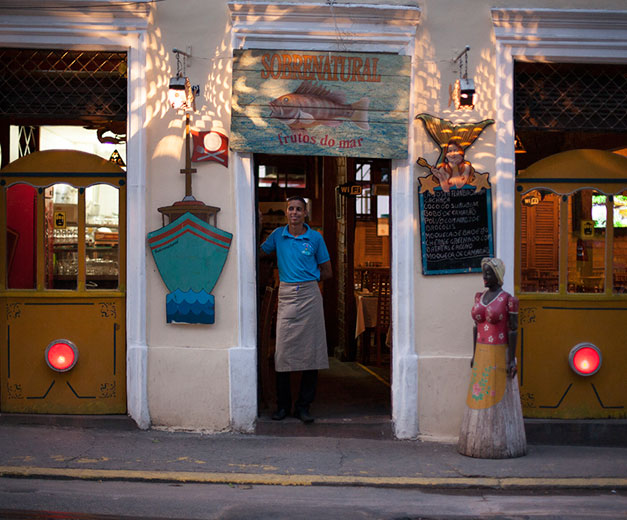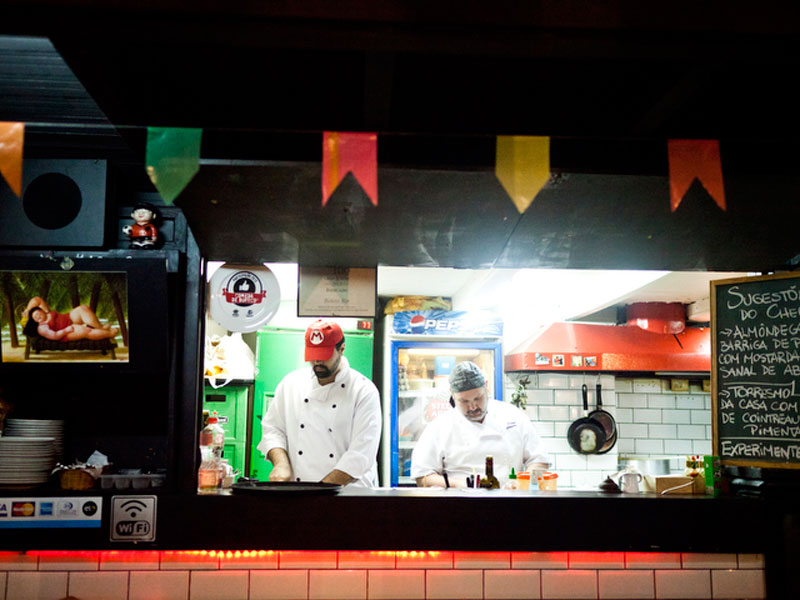We can't find the internet
Attempting to reconnect
Something went wrong!
Hang in there while we get back on track
Search results for "Taylor Barnes"
Rio
Aprazível: Paradise Found
Well-intentioned food appreciators have often made the error of believing that touristy is the opposite of authentic. The same goes for tourism and cultural exploration in general. The relentless search for the most local anything becomes based not on how locals themselves regard this thing but on how many fellow outsiders like ourselves have found it. (The fewer, the better, so goes the logic.) The localness of the thing is inverted, with the outsider becoming the arbiter of what is “authentic.” But if we, the outsiders, put so much effort into finding what is local, what’s wrong with locals making a similar effort to reach out to us?
Read moreRio
Take to the Streets: A Guide to Surviving Carnival in Rio
Carnival in Brazil can be traced back to the 17th century, when the colonial-era population threw street parties, collectively called the entrudo, which involved pelting each other with lemon-scented water. (The governor of Rio de Janeiro tried to ban such raucousness in 1604, but the party lived on.) Throughout the colonial period, Brazil’s lower classes and slaves were the protagonists of street carnival, often imitating the dress and mannerisms of the elite. The entrudo continued, with irreverent (or was it inebriated?) revelers sometimes substituting urine and feces for the scented water in the spirited street parties.
Read moreRio
Rio's Food Idioms: It's All Going to End in Pizza
You are what you eat, as the saying goes. Is it any surprise then that food figures so largely in popular culture all over the world? In Rio, food and culture go hand in hand like Romeu and Julieta (for Brazilians, that refers to white cheese and guava paste, respectively, which are such a tasty combination that they are said to be destined to be together). And perhaps nowhere is this more evident than in language – after all, the word for “language” in Portugese, língua, also means “tongue.” In Rio, what the carioca says tells us a great deal about how he eats. To wit:
Read moreRio
Espírito Santa: The Amazonian Kitchen
In a country the size of Brazil, you’ll have an easier time finding a carioca who’s been to Disney World than to the Amazon region, so cut off is it by vast forests and pricey airfares from the cosmopolitan southeastern cities of São Paulo and Rio. When we visited Manaus and took a days-long boat trip on the Rio Solimões, we introduced ourselves as American, living in Rio. Locals seemed uninterested in asking the usual litany of questions about America but grilled us on Rio, which they had only seen in evening telenovelas.
Read moreRio
Casa Paladino Comestíveis: Preservation Society
In a city filled with Technicolor snack bars, Casa Paladino Comestíveis instead looks more like the kind of place where you’d find seedy men smoking cigars in a black-and-white film. Glass cases lining the walls display manila-labeled cachaça and Cuban rum bottles, with an occasional anachronism, like boxed Toddynho chocolate milk, breaking its turn-of-the-century salon aesthetic. Cloudy mirrors, a handwritten menu and a grape-adorned Bacchus sculpture decorate its black carved wooden walls.
Read moreRio
Best Bites of 2013: Rio
Editor’s note: This post is the third installment of “Best Bites of 2013,” a roundup of our top culinary experiences over the last year. Stay tuned for “Best Bites” from all of the cities Culinary Backstreets covers. Bar do Adão There are so many good fillings – 65, in fact – for the pastéis, or fried turnovers, at Bar do Adão that we appreciate their diminutive size, which allows us to eat a greater variety in one sitting.
Read moreRio
Sobrenatural: Samba and Seafood
With 4,500 miles of coastline, the world’s largest river by volume (the Amazon), more than 10,000 miles of waterways and the largest amount of fresh water on the planet, Brazil suffers from a certain gastronomical misperception. Yes, this is a country that loves beef, prominently on display in popular Brazilian churrascarias.
Read moreRio
Gracioso: Port of Call
Rio’s Port Zone is undergoing a major facelift, and whether that will nicely polish its tired face or look like a botched Botox job remains to be seen. The port is the heart of Rio Antigo and particularly central to Afro-Brazilian history.It’s home to Rio’s first favela (squatter settlement), called Providência, which was originally populated in 1897 by veterans of the War of Canudos who were told the government would provide housing when they returned to Rio and found those promises to be delayed and elusive. At this port, up to an estimated half million slaves walked in from Brazil’s shores to then be sold in the port’s slave market, treated in a hospital if they were sick or buried if they died after arrival in Gamboa, where a fascinating makeshift museum called the Cemitério dos Pretos Novos offers a view of the human bones a homeowner found while digging on her property.
Read moreRio
Bistrô Estação R&R: Drink and Thrive
Favelas just aren’t what they used to be – or what you thought they were. Rio’s squatter settlements have grown up, though uneven development still leaves considerable gaps in terms of policing, sanitation, sewage and public services. But the favela label is increasingly arbitrary as Rio’s “slums” – we put that in quotes because we think that word often leads to some generous and inaccurate flights of imagination – start to look more like working-class bairros. And they’re working their way up to becoming the more intriguing and inviting parts of the carioca landscape.
Read moreRio
Fat Choi: Colonial Kitchen
Editor's Note: Sadly, this spot is now closed. Just inside the entrance of Fat Choi hangs a meter-tall photo of a many-armed statue of Guanyin, the Buddhist Goddess of Mercy. Iana, the daughter of Fat Choi’s founder, Silvana Assumpção, took the photo in a hotel in Macao, the infamous Chinese port and sin city. She then photoshopped out the hotel scene in the background and added bright fluffy white clouds. Macao hotels show up in posters elsewhere in the restaurant, along with a backlit aquarium with choose-your-own tilapia.
Read moreRio
Bar do Adão: The Pastel Rainbow
Perhaps nothing epitomizes Rio de Janeiro’s hedonistic approach to cuisine more than a popular deep-fried finger food: the pastel. A bite into one of these fresh, crispy stuffed dough pockets – which range from a palm-sized crescent moon to a rectangle as big as a dinner plate – releases a blow of hot steam that envelops the diner’s face in an aromatic cloud carrying the fragrance of the decadent fillings inside.
Read moreRio
Ask CB: Getting Around Rio's High Prices?
Dear Culinary Backstreets, I hear that prices in Rio are Olympic-sized. How can I eat the best the city has to offer, without spending an arm and a leg? It’s true that prices in Rio aren’t what they used to be. As a recent New York Times article notes, Brazilians pay extremely high prices (particularly relative to wages) for just about everything from food to automobiles, due to both high inflation and a tax system that’s skewed in favor of consumption taxes. The high prices hurt both consumers and businesses. As NPR reported, one Italian restaurant in Sao Paulo recently went as far as taking tomatoes off its menu because the cost had shot up so much. Meanwhile, an influx of money – from the construction boom ahead of the upcoming 2014 World Cup and 2016 Summer Olympics and from the growing oil and gas sector developing off Rio’s coast – is driving up prices even further. Indeed, what’s most surprising about Rio’s priciest locales is how oversized the lines to get into them are.
Read moreRio
Botero: Market Force
Editor's Note: Sadly, this spot is now closed. Rio’s Mercado São José looks all but abandoned during the day. The windowless white building with blue trim hosts a small fruit vendor and a thrift shop during work hours. A band practices capoeira – Brazilian martial arts – occasionally on the weekends. But the market bursts with chatter and merrymaking in the evening, thanks in large part to boyish chef Bruno Magalhães and his inventive bar and restaurant, Botero.
Read moreRio
Aconchego Carioca: Pretension-Free Zone
The Praça da Bandeira, an area of Rio that until recent years was mostly known for prostitution and cheap inner-city housing, is rapidly changing. Lying in the shadow of the massive Maracanã Stadium – built for the 1950 World Cup and the planned location of the opening ceremony of the 2016 Summer Olympics – it is alive with new construction and pedestrian traffic, which are changing the tired face of this historical but underappreciated neighborhood. And sitting snugly in the midst of this new buzz is Aconchego Carioca, a restaurant and bar with one of the best beer menus in Rio.
Read moreRio
The Protests in Rio: CB Reports
When Brazilians take to the streets and block traffic, scoff at law enforcement, set off fireworks and relieve themselves in city corners that have already seen a little too much relief, I usually assume it’s Carnaval and happily join in. But the demonstrations that have brought hundreds of thousands to the streets in recent weeks are decidedly un-carnivalesque. They are a deeply serious cry of frustration from Brazilians who, after decades of remaining quiet, are protesting the yawning gap between the success story the nation sells to outsiders and the basic needs of locals that are still far from being met.
Read moreRio
Ask CB: Exploring Rio’s Culinary Scene Safely?
Dear Culinary Backstreets, What is the situation in Rio de Janeiro these days in terms of personal safety? Is it dangerous for foreigners, or can we explore the city beyond the beachside Ipanema hotels? Rio de Janeiro is a city with two very divergent reputations. On the one hand, gringos know the city through ultraviolent films like City of God and seemingly endless news stories on shootouts between drug traffickers and police in the city’s makeshift favelas. On the other hand, it’s a seaside Carnival paradise as carefree as Carmen Miranda, swarming with deep-pocketed offshore oil workers and booming with new hotel and infrastructure construction leading up to the 2014 World Cup and 2016 Summer Olympics. What gives?
Read moreRio
Raising Cane: Cachaça’s New Day
To call someone a cachaceiro in Brazil is to deal a pretty low Portuguese blow. The word translates roughly to “drunkard” and evokes the image of an unkempt alcoholic clutching a plastic bottle of the powerful local liquor known as cachaça. It’s no coincidence that the name of the drink made with cachaça, the caipirinha, comes from the word caipira, roughly meaning “redneck” or “country.” That the national spirit is invoked in insults is emblematic of the poor image the drink has long had, but which has recently been changing. Like the newly assertive Brazil, the sugarcane-based alcohol is finding its way into chic circles where it was once seen as a bit cheap and rustic. In the past, a posh dinner host in Brazil would offer her guests a uisque (whiskey) or imported wine. But these days, it seems cariocas are finally embracing the truth: the caipirinha is a profoundly refreshing godsend on a steamy Rio summer night. A thriving cachaceiro scene is now budding both in Brazil and among a growing fan base abroad.
Read moreRio
Rio: State of the Stomach
Editor’s note: As of this week, Rio de Janeiro joins Culinary Backstreets as our sixth city. We’re thrilled to have expanded to four continents, and are looking forward to sharing with readers our explorations of this exciting city's dynamic food scene. Like many things in Brazil's beachside, party-hard Carnival city of Rio de Janeiro, gastronomy has a hedonistic edge to it.
Read more





















